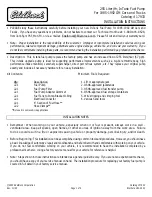
159
Starting and driving
Engine block heater
(standard equipment in Canada, acces-
sory in U.S.)
The following are just some of the benefits
to the car and the environment of using an
engine block heater:
• Lower fuel consumption.
• Exhaust emissions substantially reduced
over short runs.
• Reduced wear on the engine.
• Inside of car warms up faster.
The engine heater is effective at outside
temperatures up to +15–20°C. The warmer
it is outside, the shorter the time the engine
heater needs to be connected. Longer than
1.5 hours is unnecessary.
If the car is equipped with a removable,
electrical cabin heater that is not in use, this
should be stored in the luggage compart-
ment.
Driving in cold weather
Before starting a journey in cold weather
you should check the following:
• That the wiper blades have not become
frozen to the windshield/glass.
• Brush any snow away from the air intake
for the heater system (opening between
hood and windshield).
• It may be advisable to lubricate the door-
lock cylinder (use molybdenum
disulphide, MoS
2
) to prevent its freezing.
If the lock has frozen, take care not to
break the key (or use the remote control)
– heat it first or spray it with de-icer.
• Periodically during the winter, add gaso-
line
anti-freeze to the fuel to dispel any
condensation in the fuel tank which could
freeze and cause problems in the system.
Keep the tank well filled to reduce the risk
of condensation forming.
If the car is parked outside in freezing
weather, fuel additives (gasoline anti-
freeze) will not do any good as it cannot
remove water that has already frozen.
Park the car in a warm place so that any
ice that may have built up melts, then add
gasoline
anti-freeze when filling up the
tank. Condensation is caused by changes
in the outdoor temperature or by the car
being parked alternately in a garage and
outside.
• It is particularly important when the roads
are slippery that the brakes and tires be in
good condition.
• Check the anti-freeze in the engine coo-
lant, see page 188.
The car´s trip computer will warn you when
there is a risk of slippery conditions. For fur-
ther information on this function, see
page 62.
The car is equipped with tires designed to
provide optimum grip on both wet and dry
roads, although this has been achieved at
the expense of somewhat reduced grip on
snow and ice. For regular driving on snow
and ice, we therefore recommend that
winter (snow) tires be fitted.
Winter (snow) tires, particularly studded
tires (where use is legally permitted), gener-
ally make driving safer on snow and ice.
Acquaint yourself with the legal provi-
sions governing the use of different
types of winter tires and snow chains.
Studded tires are not allowed in some
countries
.
Содержание 2005 9-5
Страница 1: ...Owner s Manual...
Страница 12: ...10 This page has been left blank...
Страница 39: ...37 Security Doors ________________ 38 Central locking ________ 38 Car alarm _____________ 44 IB446 Security...
Страница 52: ...50 Security This page has been left blank...
Страница 252: ...250 Customer Assistance and Information This page has been left blank...
Страница 272: ...270 Notes Notes...
Страница 273: ...271 Notes...
Страница 274: ...272 Notes...
















































